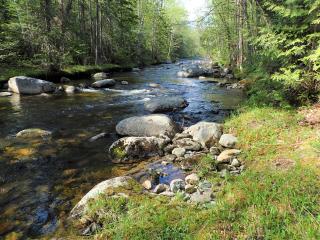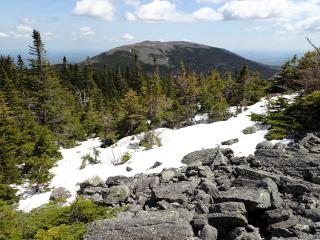Forest Legacy Program protects western Maine lands

MAINE—On May 11, the state of Maine’s Bureau of Parks and Lands and partners completed a project to permanently conserve two key properties totaling 13,606 acres using funding from the USDA Forest Service Forest Legacy Program. The Bureau of Parks and Lands worked closely with the Forest Service, Trust for Public Land, The Nature Conservancy and U.S. Department of the Navy to secure protections for both properties that help meet shared open space conservation objectives.
Situated in the state’s High Peaks region, the newly protected properties, referred to as Quill Hill and Perham Stream, expand an existing assemblage of connected, conserved lands to approximately 100,000 acres and safeguard a critical migration corridor and refuge for several animal and plant species. These properties include nine miles of streams mapped as critical brook trout habitat, documented Canada lynx denning sites, and boundaries that abut 1.5 miles of the Appalachian National Scenic Trail Corridor.
The properties also contain 24 miles of streams that feed into the Sandy and Kennebec rivers, which supply drinking water to nearly 11,000 people. The newly conserved tracts are visible from the Appalachian Trail, Mt. Abraham and Rangeley Lakes Scenic Byway and are vitally important to both the region’s outdoor recreation and forest products industry economies. They are also part of the traditional territory of the Wabanaki people and hold ongoing cultural significance.
“This collaborative project contains all the key elements that reflect Maine’s vision for conservation: a privately owned working forest that supports Maine’s timber economy, ecological reserves that sustain biodiversity, and multiple-use public land that will benefit people and wildlife for generations to come,” said Maine Bureau of Parks and Lands Director Andy Cutko.

The 7,028-acre Quill Hill property is a well-known destination that welcomes 30,000 visitors a year, drawn to its accessible 360-degree view of the High Peaks mountains. The property also features a trail system and complements nearby outdoor recreational resources, including the Northern Forest Canoe Trail and Saddleback Ski Area. Now permanently protected, the Quill Hill property will continue to be privately owned and managed and will be open for public access through a conservation easement held by the Bureau of Parks and Lands and the Navy.
On the slopes of the 4,802-foot Mt. Abraham, the 6,578-acre Perham Stream property was purchased outright by the Bureau of Parks and Lands, with the Navy also holding a conservation easement on the property.
Eighty percent of the property is in the Perham Stream watershed, which is designated as critical habitat for the federally endangered Atlantic salmon. Entirely open to public recreation as part of Maine’s Public Reserve Lands system, almost 5,000 acres are designated as an ecological reserve, while the remaining 1,600 acres will be available for sustainable timber harvest by the Bureau of Parks and Lands.
“Our nation’s forests provide immeasurable social, economic and environmental benefits that are lost when forestland is converted to non-forest uses. The Forest Service’s Forest Legacy Program directly supports our partners in pursuing mutual forest conservation objectives for the benefit of future generations,” said Gina Owens, regional forester for the Eastern Region.
Lead funding for the project came from the Forest Service’s Forest Legacy Program, with additional financial support from the Department of Defense Readiness and Environmental Protection Integration Program, and many private individuals and foundations.
